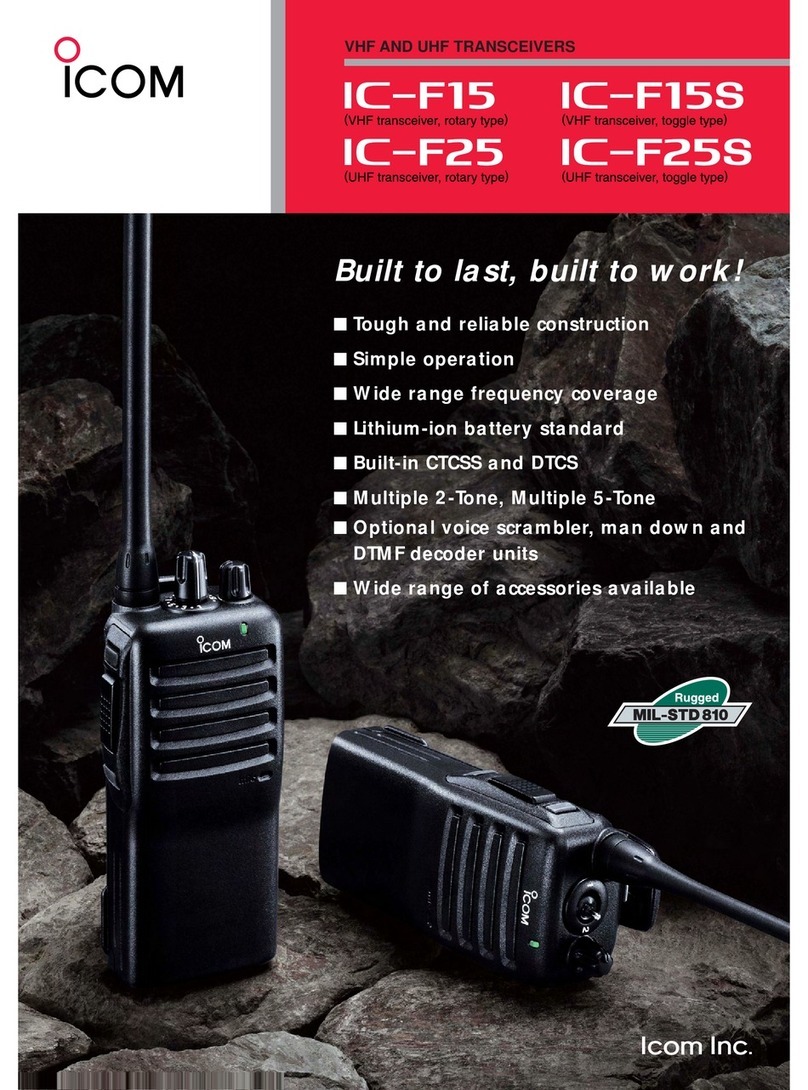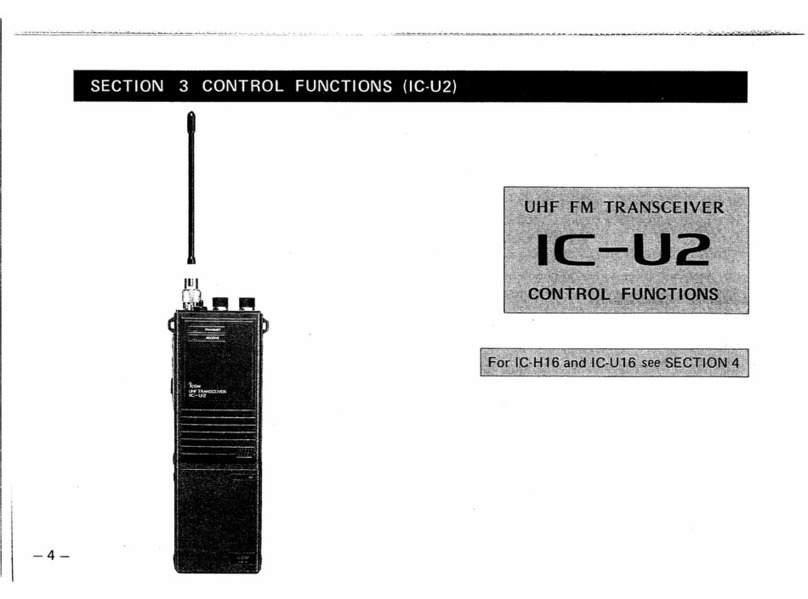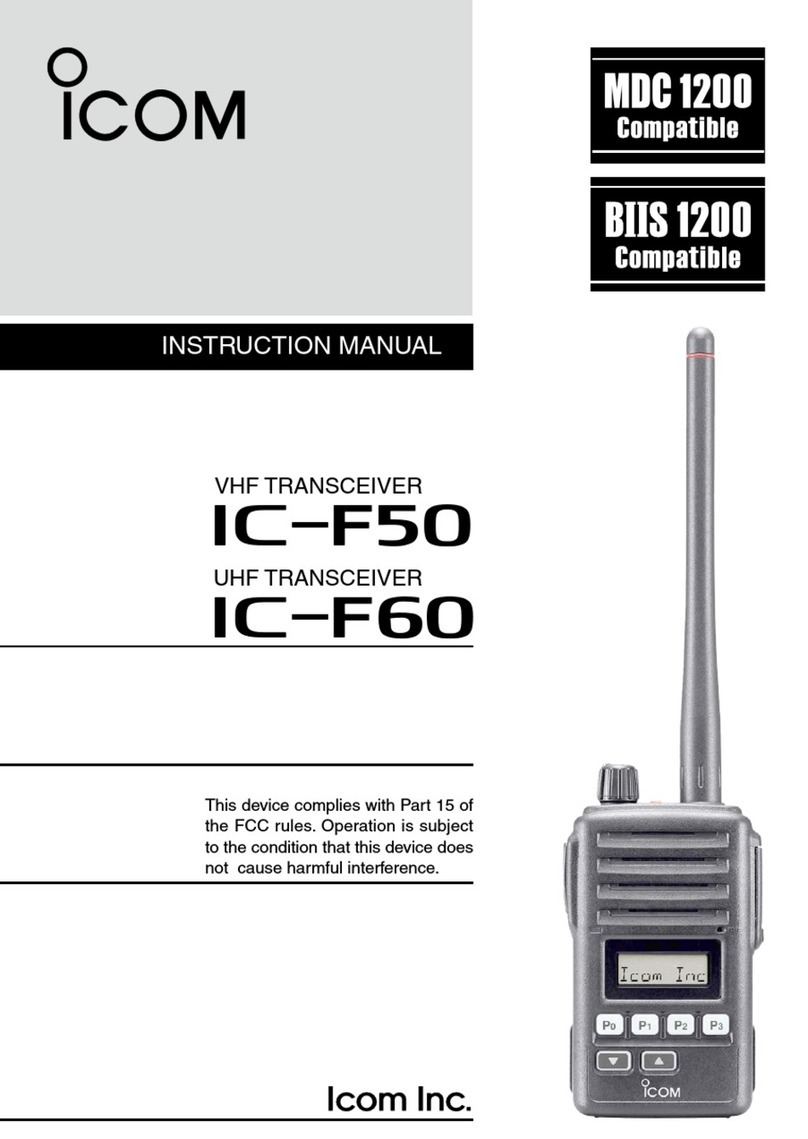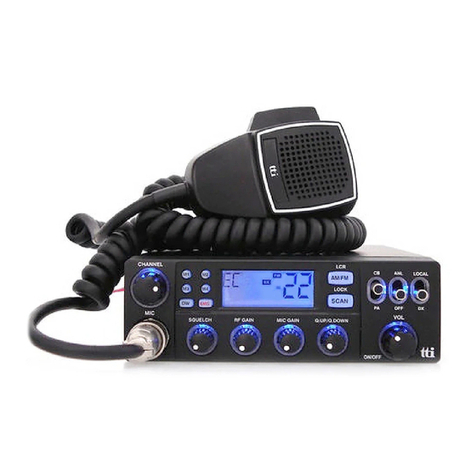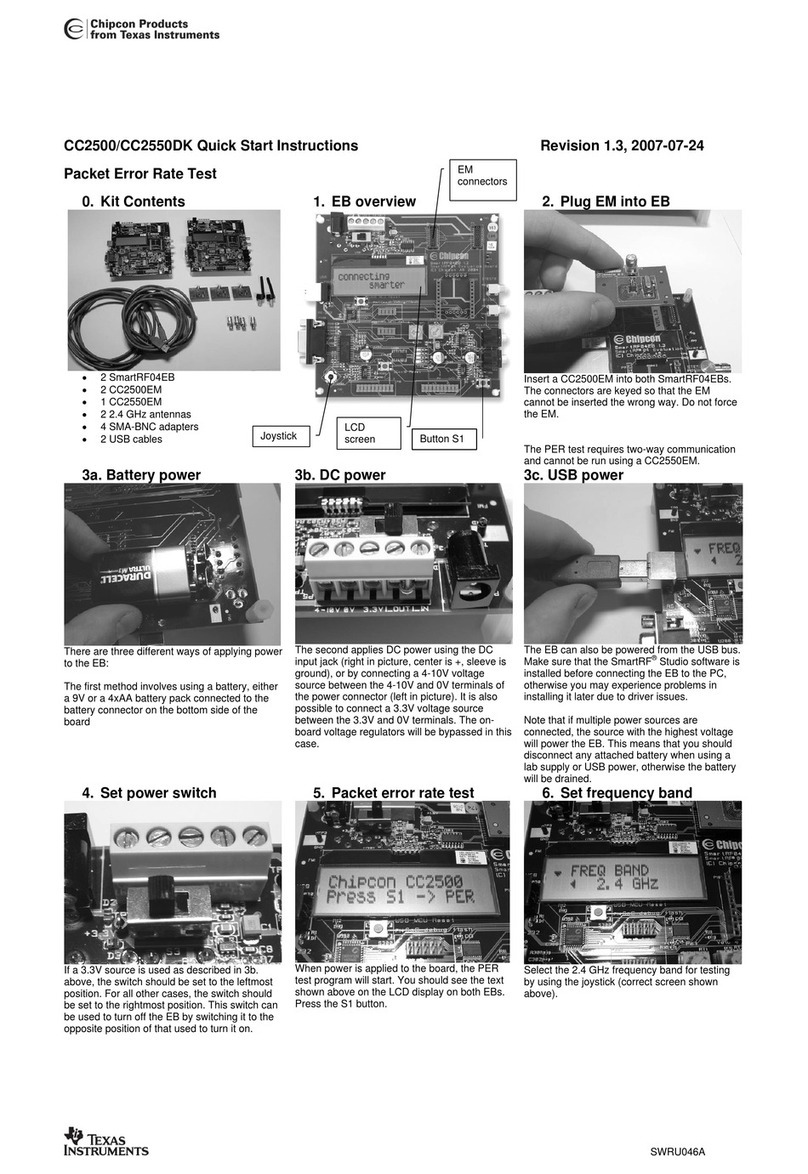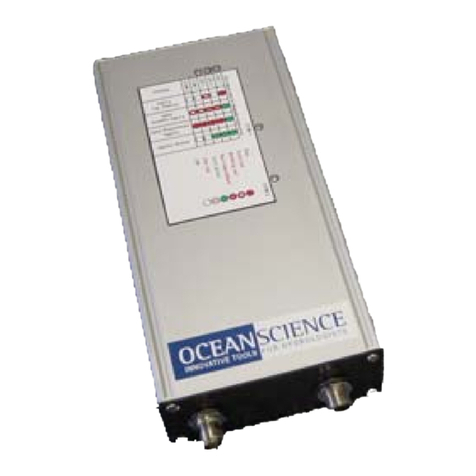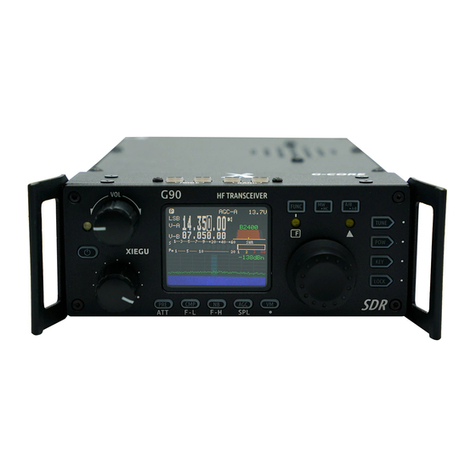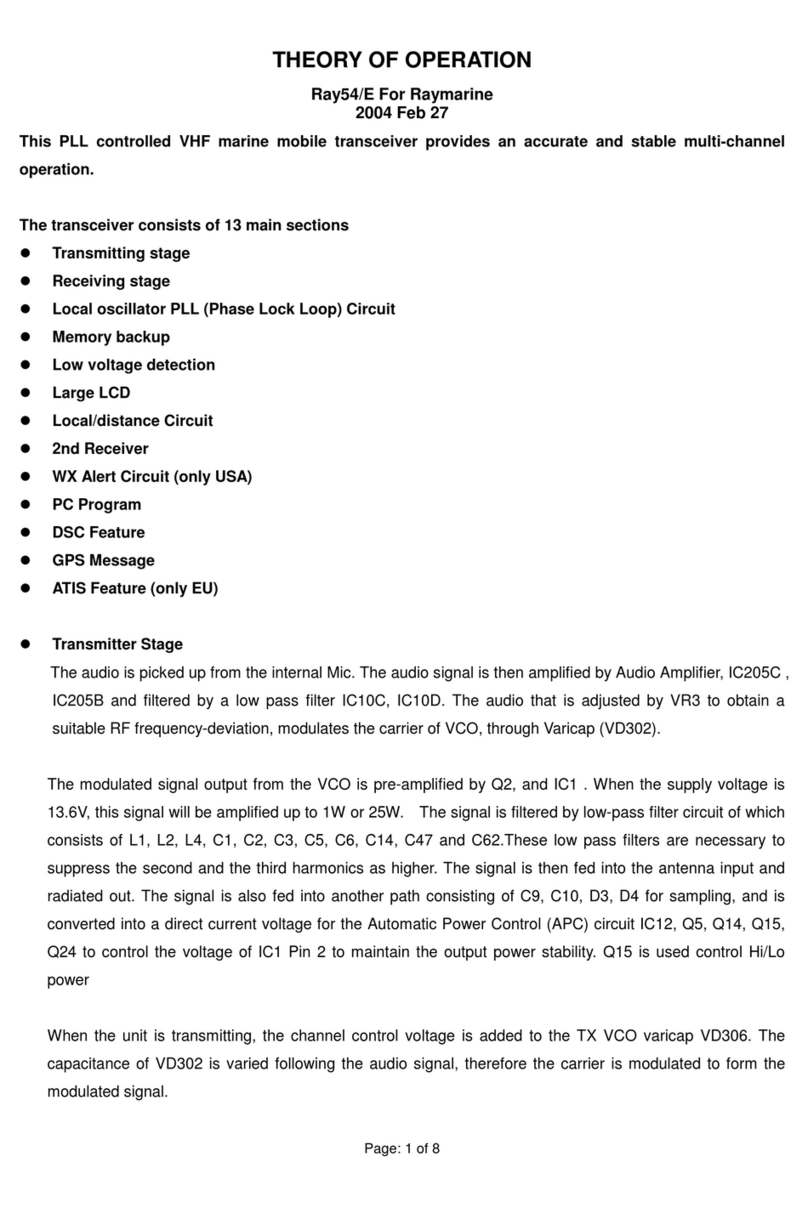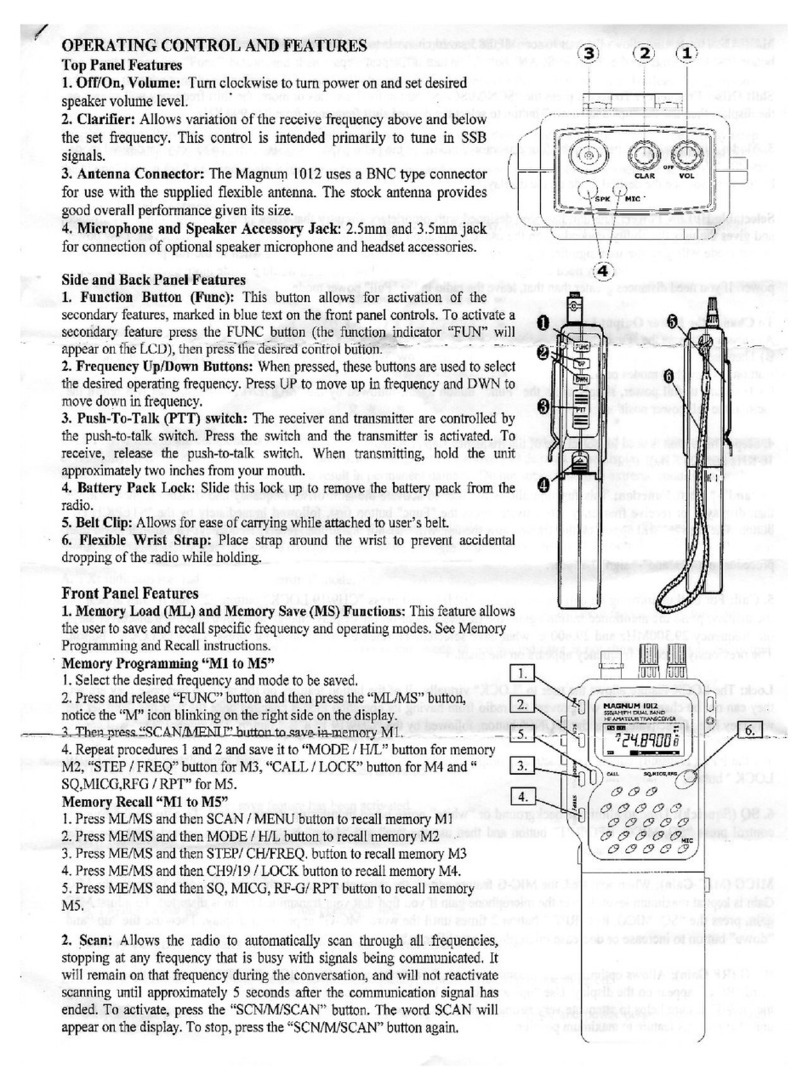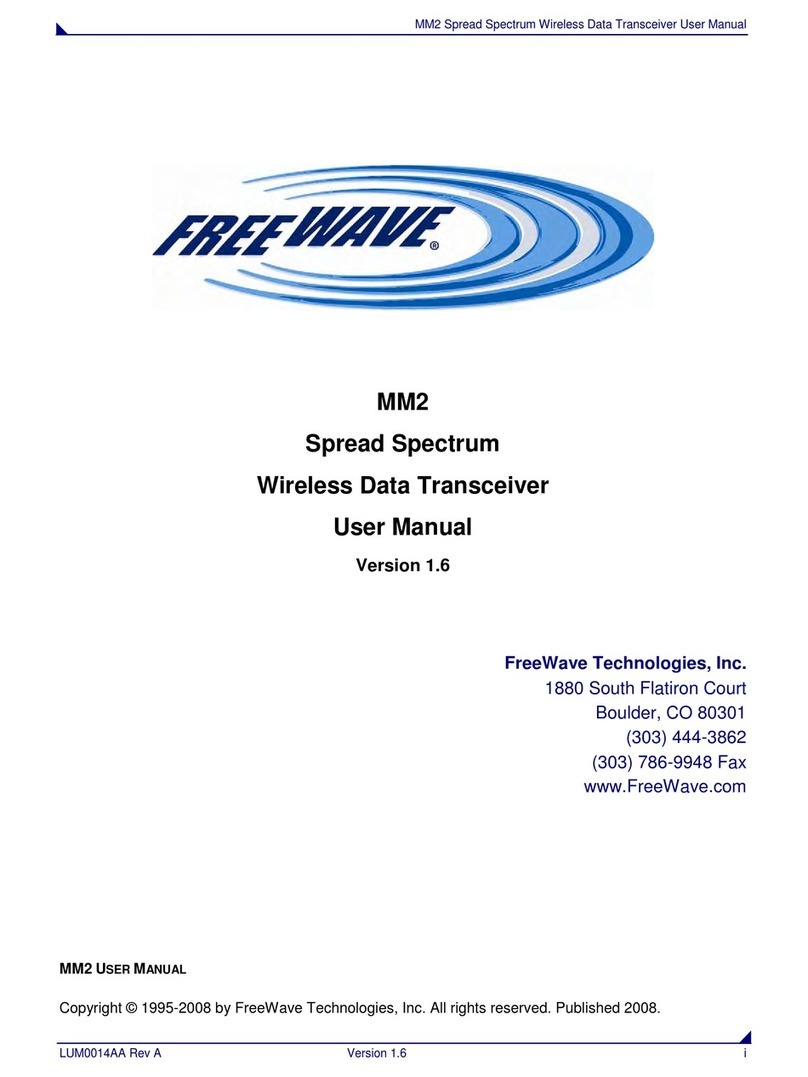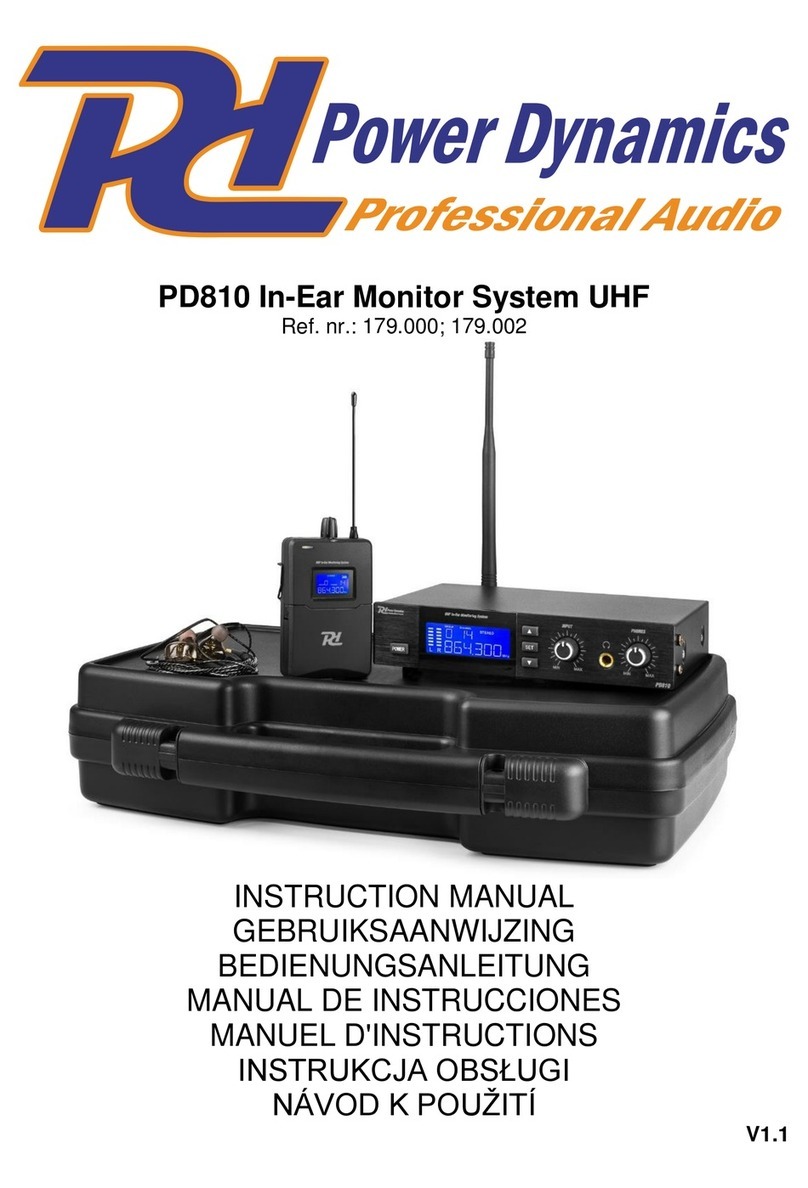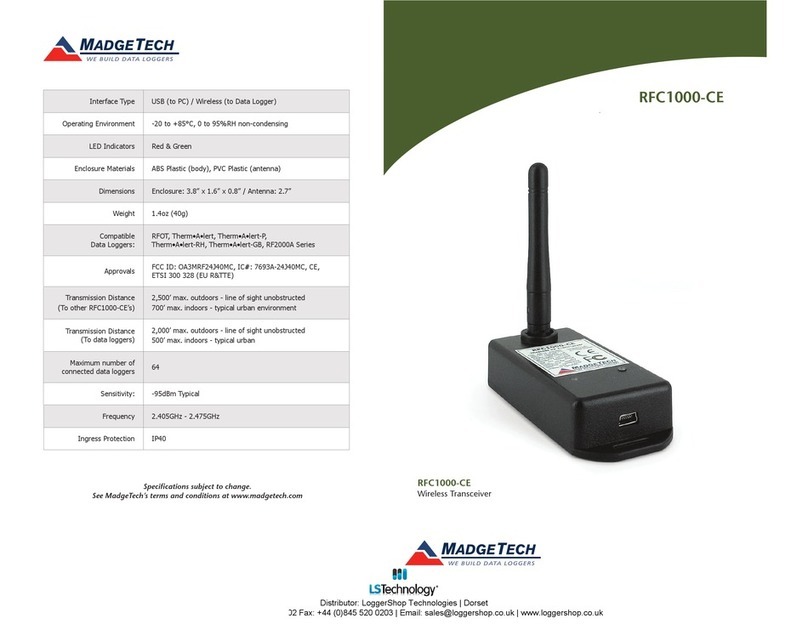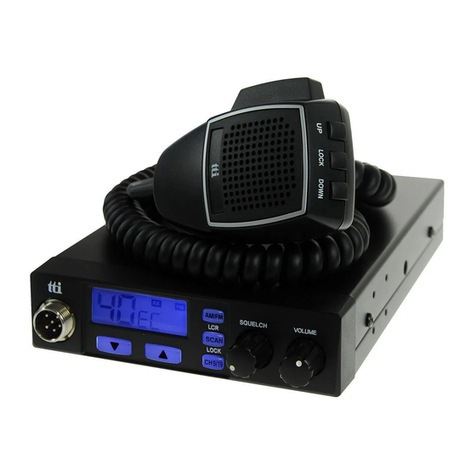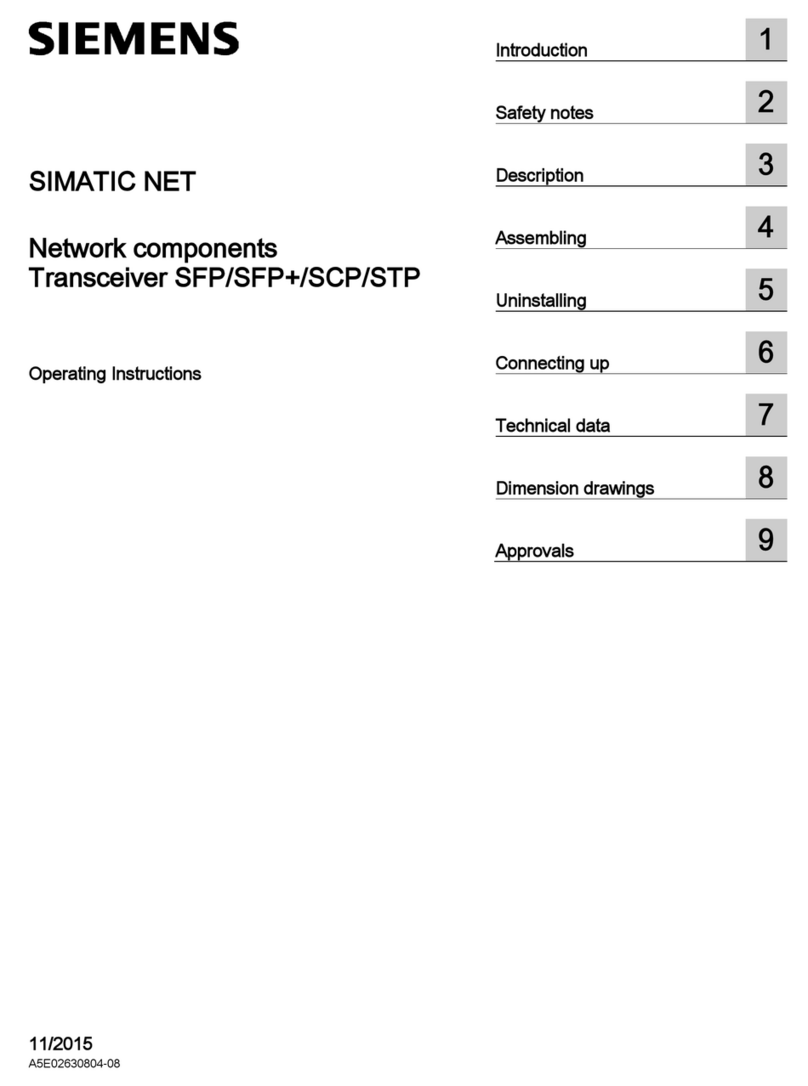Icom IC-7700 User manual

HF/50 MHz TRANSCEIVER
i7700
Instruction Manual
A6937H-1EX-7
Printed in Japan
© 2011–2018 Icom Inc.

FOREWORD Thank you for making the IC-7700 your radio of choice. We hope you agree
with Icom’s philosophy of “technology first.” Many hours of research and devel-
opment went into the design of your IC-7700.
DFEATURES
❍Ultimate receiver performance: third-order intercept (IP3) of
+40 dBm (HF bands only)
❍Built-in Baudot RTTY and PSK31 modulator/demodulator
and direct PC keyboard connection capability for RTTY and
PSK31 operations without a PC
❍High resolution spectrum scope — center frequency and fixed
frequency modes, plus mini-scope displays
IMPORTANT READ THIS INSTRUCTION MANUAL CAREFULLY before at-
tempting to operate the transceiver.
SAVETHIS INSTRUCTION MANUAL.This manual contains important
safety and operating instructions for the IC-7700.
EXPLICIT DEFINITIONS
TRADEMARKS
Icom, Icom Inc. and the Icom logo are registered trademarks of Icom
Incorporated (Japan) in Japan, the United States, the United Kingdom, Germany,
France, Spain, Russia, Australia, New Zealand, and/or other countries.
FCC INFORMATION
This equipment has been tested and found to comply with the limits for a
Class B digital device, pursuant to part 15 of the FCC Rules. These limits are
designed to provide reasonable protection against harmful interference in a
residential installation. This equipment generates, uses and can radiate radio
frequency energy and, if not installed and used in accordance with the instruc-
tions, may cause harmful interference to radio communications. However, there
is no guarantee that interference will not occur in a particular installation. If
this equipment does cause harmful interference to radio or television recep-
tion, which can be determined by turning the equipment off and on, the user
is encouraged to try to correct the interference by one or more of the following
measures:
• Reorient or relocate the receiving antenna.
• Increase the separation between the equipment and receiver.
• Connect the equipment into an outlet on a circuit different from that to which
the receiver is connected.
• Consult the dealer or an experienced radio/TV technician for help.
i
WORD DEFINITION
RDANGER! Personal death, serious injury or an explosion may occur.
RWARNING! Personal injury, fire hazard or electric shock may occur.
CAUTION Equipment damage may occur.
NOTE Recommended for optimum use. No risk of personal inju-
ry, fire or electric shock.

ii
PRECAUTIONS
RDANGER HIGH RF VOLTAGE! NEVER
attach an antenna or internal antenna connector
during transmission. This may result in an electrical
shock or burn.
RWARNING! NEVER operate the transceiver
during a lightning storm. It may result in an electric
shock, cause a fire or damage the transceiver. Always
disconnect the power source and antenna before a
storm.
RWARNING! NEVER operate the transceiver
with a headset or other audio accessories at high vol-
ume levels. Hearing experts advise against continu-
ous high volume operation. If you experience a ringing
in your ears, reduce the volume or discontinue use.
RWARNING! NEVER operate or touch the
transceiver with wet hands.This may result in an elec-
tric shock or damage to the transceiver.
RWARNING! NEVER let metal, wire or other ob-
jects protrude into the transceiver or into connectors
on the rear panel.This may result in an electric shock.
RWARNING! Immediately turn the transceiver
power OFF and remove the power cable if it emits an
abnormal odor, sound or smoke. Contact your Icom
dealer or distributor for advice.
CAUTION: NEVER put the transceiver in any un-
stable place (such as on a slanted surface or vibrated
place). This may cause injury and/or damage to the
transceiver.
CAUTION: NEVER put the transceiver’s rear
panel side down after lifting up the transceiver by
holding rack mounting handle. This may scratch the
surface of the place or damage the connectors on the
transceiver’s rear panel.
CAUTION: NEVER change the internal settings
of the transceiver.This may reduce transceiver perfor-
mance and/or damage to the transceiver.
In particular, incorrect settings for transmitter circuits,
such as output power, idling current, etc., might dam-
age the expensive final devices.
The transceiver warranty does not cover any prob-
lems caused by unauthorized internal adjustment.
CAUTION: NEVER block any cooling vents on the
top, rear or bottom of the transceiver.
CAUTION: NEVER expose the transceiver to rain,
snow or any liquids.
CAUTION: NEVER install the transceiver in a
place without adequate ventilation. Heat dissipation
may be reduced, and the transceiver may be dam-
aged.
CAUTION: The transceiver weighs approximately
22.5 kg (50 lb). Always have two people available to
carry, lift or turn over the transceiver.
CAUTION: The line-voltage receptacle must be
near the transceiver and must be easily accessible.
Avoid extension cords.
DO NOT
use harsh solvents such as benzine or al-
cohol when cleaning, as they can damage the trans-
ceiver’s surfaces.
DO NOT push the PTT switch when you don’t actu-
ally desire to transmit.
DO NOT use or store the transceiver in areas with
temperatures below ±0°C (+32°F) or above +50°C
(+122°F).
DO NOT place the transceiver in excessively dusty
environments or in direct sunlight.
DO NOT place the transceiver against walls or put-
ting anything on top of the transceiver.This may over-
heat the transceiver.
Always place unit in a secure place to avoid inadvert-
ent use by children.
BE CAREFUL! If you use a linear amplifier, set the
transceiver’s RF output power to less than the linear
amplifier’s maximum input level, otherwise, the linear
amplifier will be damaged.
BE CAREFUL! touch the transceiver top cover when
transmitting continuously for long periods of time.The
top cover may be hot.
Use Icom microphones only (supplied or optional).
Other manufacturers’ microphones have different pin
assignments, and connection to the IC-7700 may
damage the transceiver or microphone.
The LCD display may have cosmetic imperfections
that appear as small dark or light spots. This is not a
malfunction or defect, but a normal characteristic of
LCD displays.
During maritime mobile operation, keep the trans-
ceiver and microphone as far away as possible from
the magnetic navigation compass to prevent errone-
ous indications.
Turn [I/O] switch (on the rear panel) OFF and/or dis-
connect the AC power cable from the AC outlet when
you will not use the transceiver for long period of time.
For U.S.A. only
CAUTION: Changes or modifications to this device,
not expressly approved by Icom Inc., could void your
authority to operate this device under FCC regula-
tions.

qAC power cable* ................................................. 1
wFeet .............................................................. 1 pair
eSpare fuse (FGB 2 A) ......................................... 1
rRCA plugs ........................................................... 2
tDC plug ............................................................... 1
y2-conductor 1⁄8″plugs ......................................... 3
u3-conductor 1⁄8″plugs ......................................... 2
i3-conductor 1⁄4″plugs ......................................... 3
oACC plugs (7-pin) ............................................... 1
!0 ACC plugs (8-pin) ............................................... 1
!1 Antenna connector caps ..................................... 4
!2 Side screws (without rack mounting handle)†..... 6
!3 Main dial‡............................................................. 1
!4 Rubber cover for the Main dial‡............................ 1
!5 Main dial screw‡................................................... 1
!6 Hexagonal wrench‡.............................................. 1
*May differ from that shown depending on the version.
†These screws are used when removing the rack mounting
handles. See p.2-3 for the rack mounting handle detach-
ment details.
‡See p.2-2 for the main dial attachment details.
iii
SUPPLIED ACCESSORIES
q
!0 !1 !2
!3 !4 !5 !56
yui
o
e
wr
t
!2
!3
(FH M4×12 mm)
(PH M4×8 mm) PH: Pan head
FH: Flat head
Icom is not responsible for the destruction or damage to
the Icom transceiver, if the malfunction is because of:
•Force majeure, including, but not limited to,
fires,earthquakes, storms, floods, lightnings, or
other naturaldisasters, disturbances, riots, war, or
radioactivecontamination.
•The use of Icom transceiver with any equipment
that is not manufactured or approved by Icom.

iv
Section 1 PANEL DESCRIPTION
■Front panel ........................................................................................ 1-2
■Rear panel ...................................................................................... 1-12
■LCD display .................................................................................... 1-14
■Screen menu arrangement ............................................................. 1-16
Section 2 INSTALLATION AND CONNECTIONS
■Unpacking ......................................................................................... 2-2
■Main dial attachment ........................................................................ 2-2
■Rack mounting handle detachment .................................................. 2-3
■Selecting a location .......................................................................... 2-3
■Grounding ......................................................................................... 2-4
■Antenna connection .......................................................................... 2-4
■USB flash drive connection .............................................................. 2-4
■Required connections ....................................................................... 2-5
DFront panel ................................................................................... 2-5
DRear panel .................................................................................... 2-5
■Advanced connections ..................................................................... 2-6
DFront panel ................................................................................... 2-6
DRear panel—1 .............................................................................. 2-6
DRear panel—2 .............................................................................. 2-7
■Linear amplifier connections ............................................................. 2-8
DConnecting the IC-PW1/EURO .................................................... 2-8
DConnecting a non-Icom linear amplifier ........................................ 2-8
■Transverter jack information ............................................................. 2-9
■FSK and AFSK connections ............................................................. 2-9
DWhen using the ACC socket or the microphone connector .......... 2-9
■Microphones (options) .................................................................... 2-10
DSM-50 ......................................................................................... 2-10
DSM-30 ......................................................................................... 2-10
DHM-36 ......................................................................................... 2-11
■Microphone connector information ................................................. 2-11
■Accessory connector information ................................................... 2-12
Section 3 BASIC OPERATIONS
■When first applying power (CPU resetting) ...................................... 3-2
■Initial settings .................................................................................... 3-2
■Selecting VFO/memory mode .......................................................... 3-3
■VFO selection ................................................................................... 3-3
DSelecting VFO-A/VFO-B ............................................................... 3-3
DVFO equalization .......................................................................... 3-3
■Selecting an operating band ............................................................. 3-4
DUsing the band stacking registers ................................................ 3-4
■Frequency setting ............................................................................. 3-5
DTuning with the main dial .............................................................. 3-5
DDirect frequency entry with the keypad ........................................ 3-5
DQuick tuning step .......................................................................... 3-6
DSelecting “kHz” step ..................................................................... 3-6
D1⁄4tuning step function ................................................................. 3-6
DSelecting 1 Hz step ...................................................................... 3-7
DAuto tuning step function .............................................................. 3-7
■Operating mode selection ................................................................ 3-8
■Volume setting .................................................................................. 3-9
■RF gain adjustment .......................................................................... 3-9
■Squelch level adjustment .................................................................. 3-9
TABLE OF CONTENTS

■Meter indication selection ............................................................... 3-10
DMulti-function digital meter ......................................................... 3-10
DMeter type selection ................................................................... 3-11
■Voice synthesizer operation ............................................................ 3-11
■Basic transmit operation ................................................................. 3-12
DTransmitting ................................................................................ 3-12
DMicrophone gain adjustment ...................................................... 3-12
DDrive gain adjustment ................................................................. 3-13
■Band edge warning beep ............................................................... 3-13
DProgramming the user band edge .............................................. 3-14
Section 4 RECEIVE AND TRANSMIT
■Operating SSB .................................................................................. 4-2
DConvenient functions for receive ...................................................4-2
DConvenient functions for transmit ..................................................4-3
DAbout 5 MHz band operation (USA version only) .........................4-3
■Operating CW ................................................................................... 4-4
DConvenient functions for receive ...................................................4-4
DConvenient functions for transmit ..................................................4-5
DAbout CW reverse mode ...............................................................4-5
DAbout CW pitch control .................................................................4-5
DCW side tone function ...................................................................4-5
DAPF (Audio Peak Filter) operation .................................................4-6
■Electronic keyer functions ................................................................. 4-7
DMemory keyer screen ....................................................................4-8
DEditing a memory keyer .................................................................4-9
DContest number set mode ...........................................................4-10
DKeyer set mode ...........................................................................4-11
■Operating RTTY (FSK) ................................................................... 4-13
DConvenient functions for receive .................................................4-14
DAbout RTTY reverse mode ..........................................................4-14
DTwin peak filter .............................................................................4-14
DFunctions for the RTTY decoder display .....................................4-15
DSetting the decoder threshold level .............................................4-15
DRTTY memory transmission ........................................................4-16
DAutomatic transmission/reception setting ....................................4-16
DEditing RTTY memory .................................................................4-17
DRTTY decode set mode ..............................................................4-18
DData saving ..................................................................................4-20
■Operating PSK ................................................................................ 4-21
DConvenient functions for receive .................................................4-22
DAbout BPSK and QPSK modes ..................................................4-22
DFunctions for the PSK decoder display .......................................4-23
DSetting the decoder threshold level .............................................4-23
DPSK memory transmission ..........................................................4-24
DAutomatic transmission/reception setting ....................................4-24
DEditing PSK memory ...................................................................4-25
DPSK decode set mode ................................................................4-26
DData saving ..................................................................................4-28
■Operating AM ................................................................................. 4-29
DConvenient functions for receive .................................................4-29
DConvenient functions for transmit ................................................4-30
■Operating FM .................................................................................. 4-31
DConvenient functions for receive .................................................4-31
v
TABLE OF CONTENTS

vi
DConvenient functions for transmit ................................................4-31
■Repeater operation ......................................................................... 4-32
DRepeater access tone frequency setting .....................................4-33
■Tone squelch operation .................................................................. 4-34
■Data mode (AFSK) operation ......................................................... 4-35
Section 5 FUNCTIONS FOR RECEIVE
■Spectrum scope screen .................................................................... 5-2
DCenter mode ................................................................................. 5-2
DFixed mode ................................................................................... 5-3
DMini scope screen display ............................................................ 5-4
DScope set mode ........................................................................... 5-4
DUSB mouse operation .................................................................. 5-9
■Preamplifier .................................................................................... 5-10
■Attenuator ....................................................................................... 5-10
■RIT function .................................................................................... 5-11
DRIT monitor function ....................................................................5-11
■AGC function .................................................................................. 5-12
DSelecting the preset value ...........................................................5-12
DAdjusting the AGC time constant ................................................5-12
DSetting the AGC time constant preset value ...............................5-12
■Twin PBT operation ........................................................................ 5-13
■IF filter selection ............................................................................. 5-14
DIF filter selection ......................................................................... 5-14
DFilter passband width setting (except FM mode) ....................... 5-14
DRoofing filter selection ................................................................ 5-15
DDSP filter shape ......................................................................... 5-15
DFilter shape set mode ................................................................. 5-15
■Noise blanker .................................................................................. 5-16
DNB set mode ............................................................................... 5-17
■Noise reduction ............................................................................... 5-18
■Dial lock function ............................................................................ 5-18
■Notch function ................................................................................. 5-19
■Digital selector ................................................................................ 5-19
■Audio scope screen ........................................................................ 5-20
DAudio scope set mode ................................................................ 5-21
■Autotune function ............................................................................ 5-22
Section 6 FUNCTIONS FOR TRANSMIT
■VOX function ..................................................................................... 6-2
DUsing the VOX function ................................................................ 6-2
DAdjusting the VOX function ........................................................... 6-2
DVOX set mode .............................................................................. 6-2
■Break-in function ............................................................................... 6-3
DSemi break-in operation ............................................................... 6-3
DFull break-in operation .................................................................. 6-3
■∂TX function ..................................................................................... 6-4
D∂TX monitor function .................................................................... 6-4
■Monitor function ................................................................................ 6-4
■Transmit filter width setting (SSB only) ............................................. 6-5
■Speech compressor (SSB only)........................................................ 6-5
■Split frequency operation .................................................................. 6-6
■Quick split function ........................................................................... 6-7
DSplit lock function ......................................................................... 6-7
TABLE OF CONTENTS

Section 7 VOICE RECORDER FUNCTIONS
■Recording a QSO audio ……………………………………………… 7-2
DTo start or stop recording…………………………………………… 7-2
■Recording quick operation …………………………………………… 7-2
DTo start or stop recording…………………………………………… 7-2
■Playing back recorded audio (QSO) ………………………………… 7-3
DBasic playing ………………………………………………………… 7-3
DOperating while playing back ……………………………………… 7-4
■Deleting recorded audio file …………………………………………… 7-5
■Deleting recorded audio folder………………………………………… 7-5
■About digital voice recorder …………………………………………… 7-6
■Recording a received audio (Short REC) …………………………… 7-7
DOne-touch recording ………………………………………………… 7-7
■Playing back the recorded audio (Short REC) ……………………… 7-7
DBasic playing ………………………………………………………… 7-7
DOne-touch playing …………………………………………………… 7-8
■Protect the recorded contents ………………………………………… 7-8
■Erasing the recorded contents………………………………………… 7-8
■Recording a message for transmit …………………………………… 7-9
DRecording …………………………………………………………… 7-9
DConfirming a message for transmit………………………………… 7-9
■Programming a memory name ………………………………………7-10
■Sending a recorded message …………………………………………7-11
DSingle TX………………………………………………………………7-11
DRepeat TX ……………………………………………………………7-11
DTransmit level setting ………………………………………………7-12
■Voice set mode …………………………………………………………7-12
■Saving a voice memory into the memory device ……………………7-15
DSaving the received audio memory ………………………………7-15
DSaving the TX memory………………………………………………7-15
Section 8 MEMORY OPERATION
■Memory channels ............................................................................. 8-2
■Memory channel selection ................................................................ 8-2
DUsing the ∫/ √keys ......................................................... 8-2
DUsing the keypad .......................................................................... 8-2
■Memory channel programming ......................................................... 8-3
DProgramming in VFO mode .......................................................... 8-3
DProgramming in memory mode .................................................... 8-3
■Frequency transfers .......................................................................... 8-4
DTransferring in VFO mode ............................................................. 8-4
DTransferring in memory mode ....................................................... 8-4
■Memory list screen ........................................................................... 8-5
DSelecting a memory channel using the memory list screen ........ 8-5
DConfirming programmed memory channels ................................. 8-5
■Memory names ................................................................................. 8-6
DEditing (programming) memory names ........................................ 8-6
■Memory clearing ............................................................................... 8-6
■Memo pads........................................................................................ 8-7
DWriting frequencies and operating modes into memo pads ......... 8-7
DCalling up a frequency from a memo pad .................................... 8-7
vii
TABLE OF CONTENTS

viii
Section 9 SCANS
■Scan types ........................................................................................ 9-2
■Preparation ....................................................................................... 9-2
■Voice squelch control function .......................................................... 9-3
■Scan set mode ................................................................................. 9-3
■Programmed scan operation ............................................................ 9-4
■∂F scan operation ............................................................................ 9-4
■Fine programmed scan/Fine ∂F scan .............................................. 9-5
■Memory scan operation .................................................................... 9-6
■Select memory scan operation ......................................................... 9-6
■Setting select memory channels ...................................................... 9-7
DSetting in scan screen .................................................................. 9-7
DSetting in memory list screen ....................................................... 9-7
DErasing the select scan setting .................................................... 9-7
■Tone scan ......................................................................................... 9-8
Section 10 ANTENNA TUNER OPERATION
■Antenna connection and selection ................................................. 10-2
■Antenna memory settings ............................................................... 10-3
DAntenna type selection ............................................................... 10-3
DTemporary memory .................................................................... 10-4
DAntenna selection mode ............................................................. 10-4
DReceive antenna I/O setting ....................................................... 10-5
■Antenna tuner operation ................................................................. 10-6
DTuner operation ........................................................................... 10-6
DIf the tuner cannot tune the antenna .......................................... 10-7
Section 11 CLOCK AND TIMERS
■Time set mode ................................................................................ 11-2
■Daily timer setting ........................................................................... 11-3
■Setting sleep timer .......................................................................... 11-4
■Timer operation .............................................................................. 11-4
Section 12 SET MODE
■Set mode description ...................................................................... 12-2
DSet mode operation .................................................................... 12-2
DScreen arrangement ................................................................... 12-3
■Level set mode ............................................................................... 12-4
■ACC set mode ................................................................................ 12-7
■Display set mode .......................................................................... 12-10
■Others set mode ........................................................................... 12-12
■USB-Memory set menu ................................................................ 12-23
DUSB-Memory set screen arrangement ..................................... 12-23
DSave option set mode ............................................................... 12-24
DLoad option set mode ............................................................... 12-25
■File saving .................................................................................... 12-26
■File loading ................................................................................... 12-27
■Changing a file name ................................................................... 12-28
■Deleting a file ................................................................................ 12-29
■Unmounting USB flash drive ........................................................ 12-29
■Formatting USB flash drive .......................................................... 12-30
TABLE OF CONTENTS

Section 13 MAINTENANCE
■Troubleshooting .............................................................................. 13-2
DTransceiver power ....................................................................... 13-2
DTransmit and receive .................................................................. 13-2
DScanning ..................................................................................... 13-3
DDisplay ........................................................................................ 13-3
DFormat USB flash drive .............................................................. 13-3
■Main dial brake adjustment ............................................................ 13-3
■SWR reading .................................................................................. 13-4
■Screen type and font selections ..................................................... 13-4
■Frequency calibration (approximate) .............................................. 13-5
■Opening the transceiver’s case ...................................................... 13-6
■Clock backup battery replacement ................................................. 13-6
■Fuse replacement ........................................................................... 13-7
■Resetting the CPU .......................................................................... 13-7
■About protection indications ........................................................... 13-8
■Screen saver function ..................................................................... 13-8
Section 14 CONTROL COMMAND
■Remote jack (CI-V) information ...................................................... 14-2
DCI-V connection example ........................................................... 14-2
DData format ................................................................................. 14-2
DCommand table .......................................................................... 14-3
DData contents description.......................................................... 14-10
Section 15 SPECIFICATIONS AND OPTIONS
■Specifications ................................................................................. 15-2
DGeneral ....................................................................................... 15-2
DTransmitter .................................................................................. 15-2
DReceiver ...................................................................................... 15-3
DAntenna tuner ............................................................................. 15-3
■Options ........................................................................................... 15-4
Section 16 UPDATING THE FIRMWARE
■General ........................................................................................... 16-2
DFirmware confirmation ................................................................ 16-2
■Caution ........................................................................................... 16-2
■Preparation ..................................................................................... 16-3
DFirmware and firm utility ............................................................. 16-3
DFile downloading ....................................................................... 16-3
■Firmware update— USB flash drive ............................................... 16-4
■Firmware update— PC ................................................................... 16-6
DConnections ................................................................................ 16-6
DIP address setting ....................................................................... 16-7
DUpdating from a PC .................................................................... 16-8
ix
TABLE OF CONTENTS

1-1
PANEL DESCRIPTION Section 1
■Front panel ........................................................................................ 1-2
■Rear panel ...................................................................................... 1-12
■LCD display .................................................................................... 1-14
■Screen menu arrangement ............................................................. 1-16

1-2
qPOWER SWITCH POWER (p. 3-2)
➥Push to turn the transceiver power ON.
• The [POWER] indicator above this switch lights
green when powered ON.
➥Hold down for 1 second to turn the transceiver
power OFF.
• The [POWER] indicator lights orange when the
transceiver is OFF when the internal power supply
is switched ON.
wTRANSMIT SWITCH TRANSMIT
Selects transmit or receive.
• The [TX] indicator lights red while transmitting and the
[RX] indicator lights green when the squelch is open.
eANTENNATUNER SWITCH TUNER (p. 10-6)
➥Turns the internal antenna tuner ON or OFF (by-
pass) when pushed momentarily.
• The [TUNER] indicator above this switch lights
green when the tuner is turned ON, goes off when
tuner is turned OFF (bypassed).
➥Tunes the antenna tuner manually when held
down for 1 second.
• The [TUNER] indicator blinks red during manual tun-
ing.
• When the tuner cannot tune the antenna, the tuning
circuit is automatically bypassed after 20 seconds.
rTIMER SWITCH TIMER (p. 11-4)
➥Turns the sleep or daily timer function ON or
OFF.
• The [TIMER] indicator above this switch lights green
when the timer is in use.
➥Selects the timer set mode when held down for
1 second.
tHEADPHONE JACK [PHONES]
Accepts standard stereo headphones.
• Output power: 5 mW with an 8 Ωload.
• When headphones are connected, the internal speaker
or connected external speaker does not function.
yELECTRONIC KEYER JACK [ELEC-KEY] (p. 2-5)
Accepts a paddle to activate the internal electronic
keyer for CW operation.
•You can select internal electronic keyer, bug-key or
straight key operation in keyer set mode. (p. 4-12)
• A straight key jack is located on the rear panel. See
[CW KEY] on page 1-12.
• Keyer polarity (dot and dash) can be reversed in keyer
set mode. (p. 4-12)
• A 4-channel memory keyer is available for your con-
venience. (p. 4-8)
(dot)
(com)
(dash)
Turn the internal power supply ON first. The in-
ternal power supply switch is located on the rear
panel. (p. 3-2)
1PANEL DESCRIPTION
POWER
TUNER
TIMER
VOX
SSB CW
RTTY/PSK
AM/FM DATA AUTO
TUNE
LOCK
TS
XFC
M.SCOPE
EXIT/SET
REC
PLAY
VOICE MEMORYBRIGHTCONTRASTVOX GAINMONI GAINCOMPDRIVE ANTI VOX
BK-IN MONITOR
TRANSMIT
MIC
ELEC-KEY
PHONES
AF RF
MIC RF
PWR
DIGI-SEL NOTCH
RIT/∂TX
CW PITCH
TWIN-PBT
KEY
SPEED
DELAY
F-1F-2 F-3F-4 F-5F-6 F-7
LOCKTX RX SPLIT
AGC VR
NR
FILTER
PBT-CLR
DIGI-SEL
APF/TPF
NOTCH
RIT
CLEAR
SPEECH
1
1.8
2
3.5
3
7
4
10
5
14
6
18
7
21
8
24
MP-W MP-R
MW V/M
A/B A=B
9
28
GENE
0
50
ENT
F-INP
∂TX
NB
SPLIT
AGC SQL NR NB
q
w
e
r
t
y
u
!5
io!0 !1 !2 !3 !4
!6
■Front panel

Please record the serial number of your IC-7700 transceiver below for future servicing
reference:
Serial Number :
Date of purchase :
Place where purchased :

1-1-32 Kamiminami, Hirano-ku, Osaka 547-0003, Japan
Printed on recycled paper with soy ink�
Other manuals for IC-7700
7
Table of contents
Other Icom Transceiver manuals
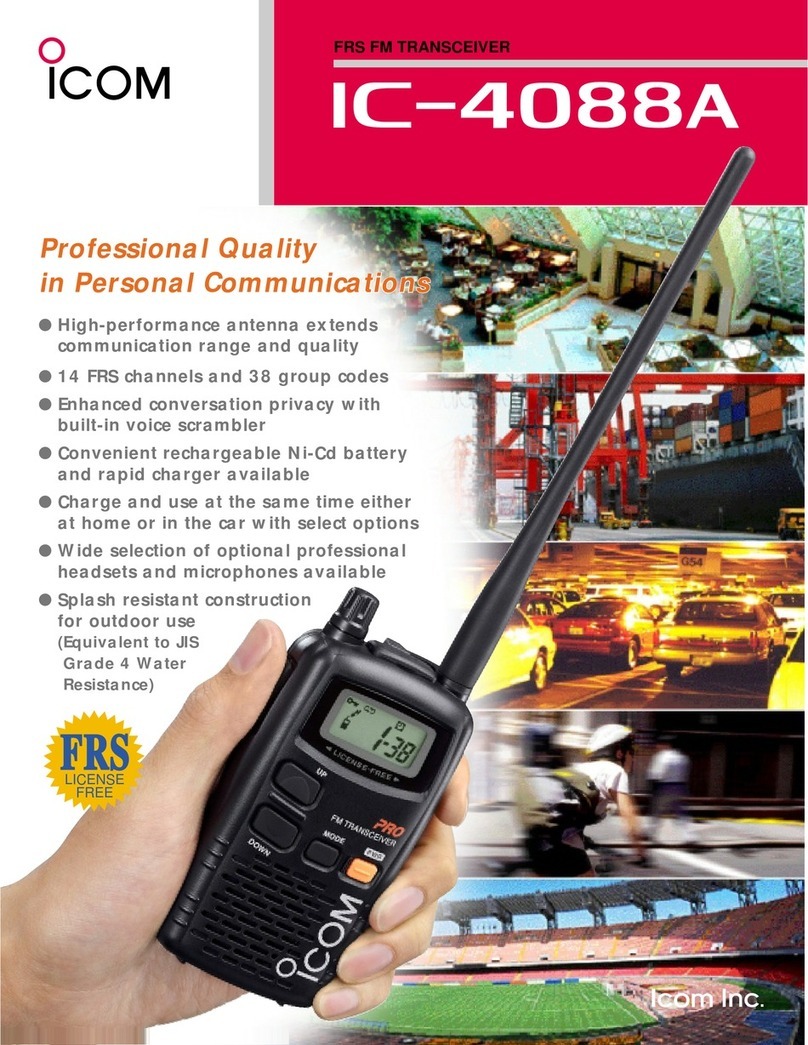
Icom
Icom IC-4088A User manual

Icom
Icom IC-7300 Installation guide
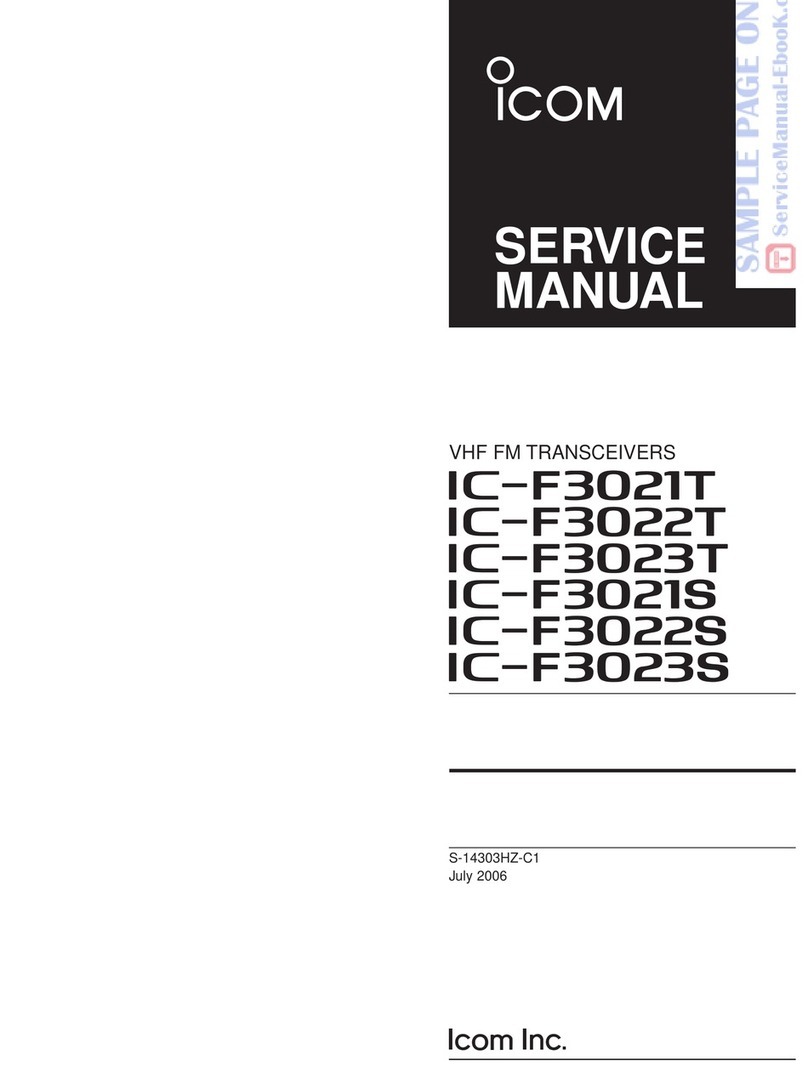
Icom
Icom IC-F3021T User manual

Icom
Icom IC-7800 User manual
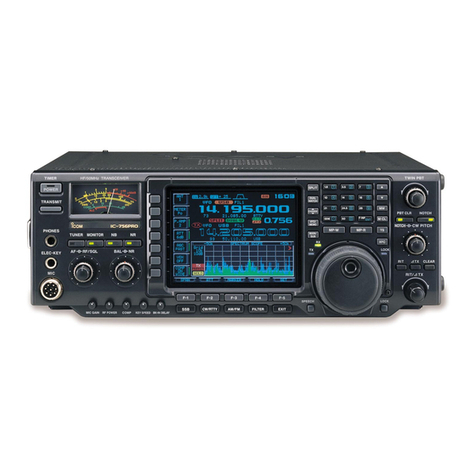
Icom
Icom IC-756PRO III User manual
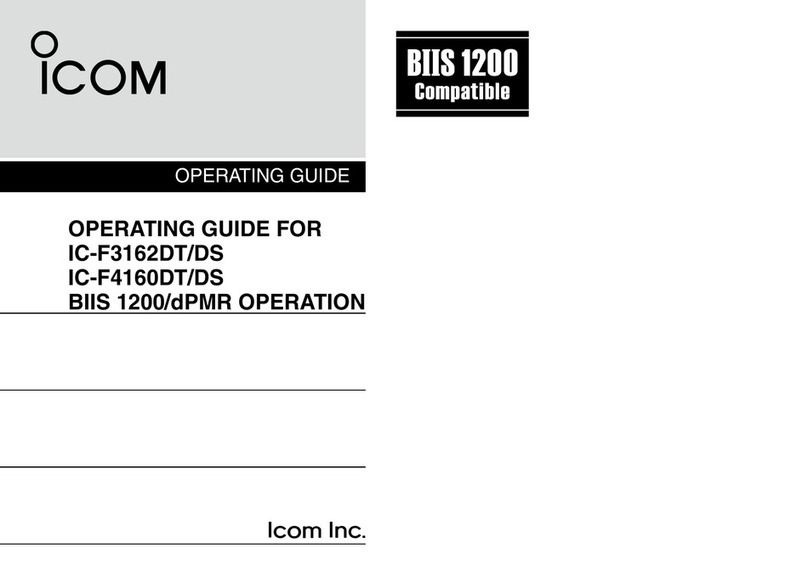
Icom
Icom IC-F4160DS User manual
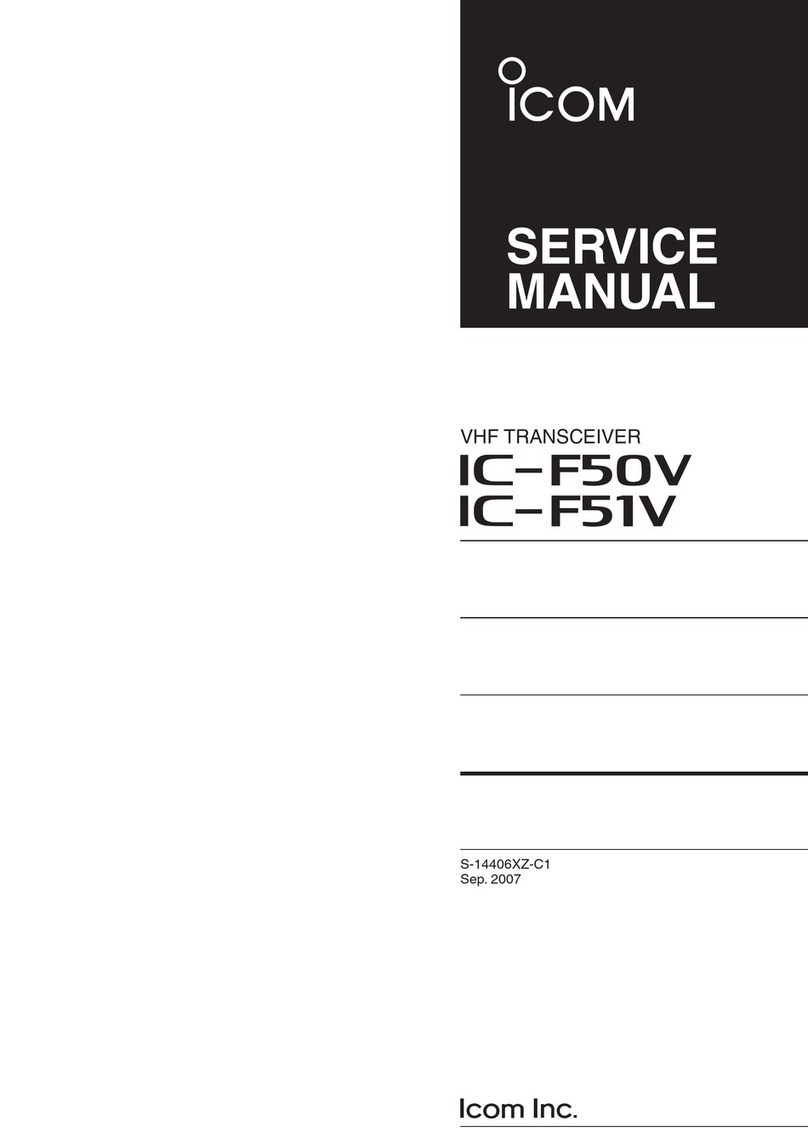
Icom
Icom IC-F50V User manual
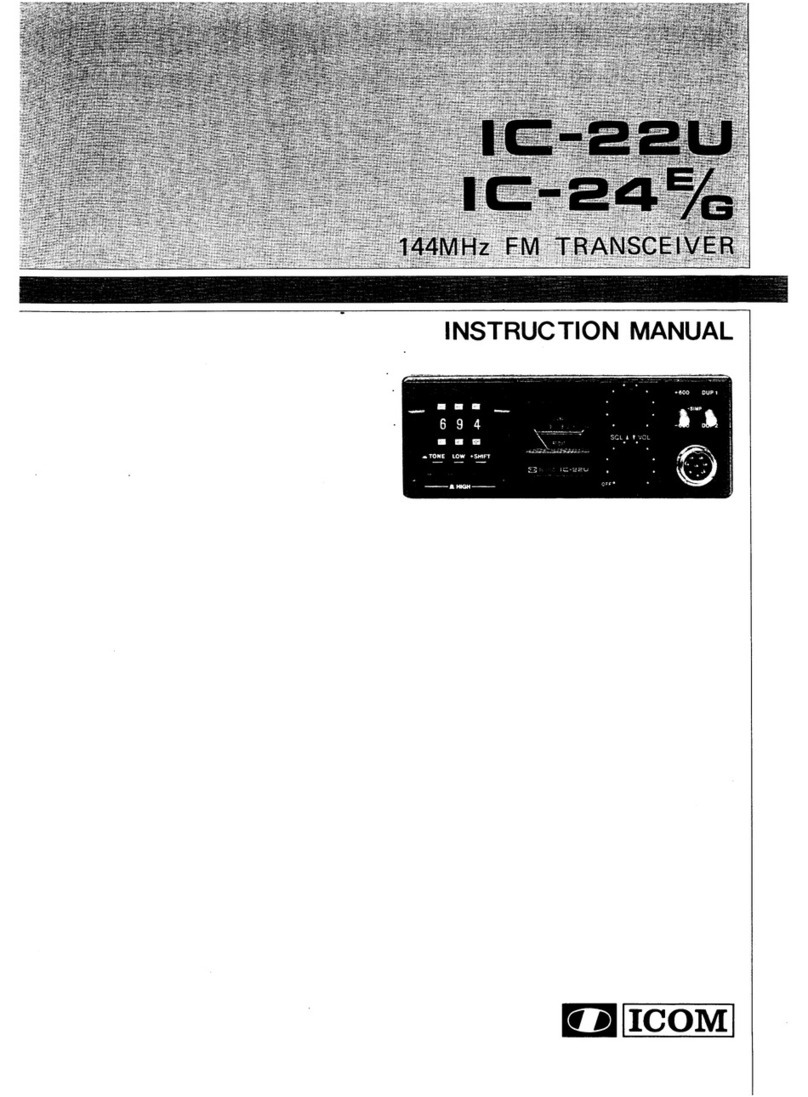
Icom
Icom IC-22U User manual
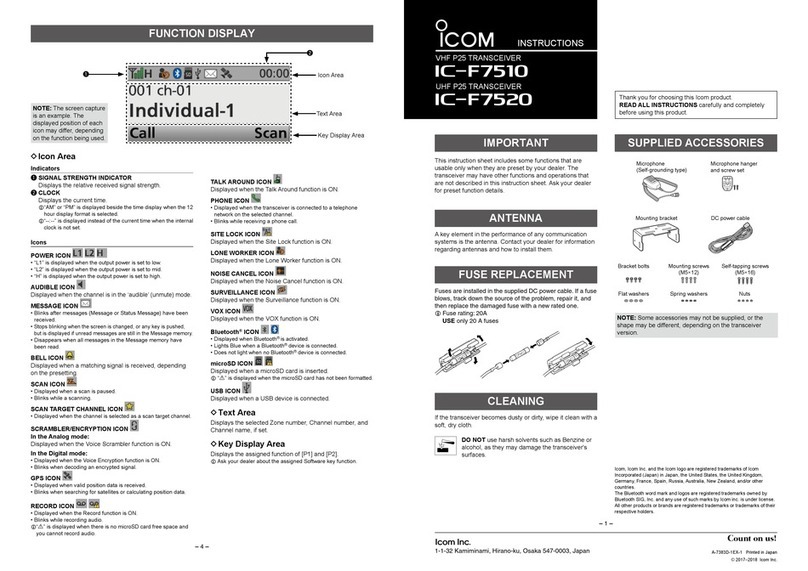
Icom
Icom IC-F7510 Series User manual
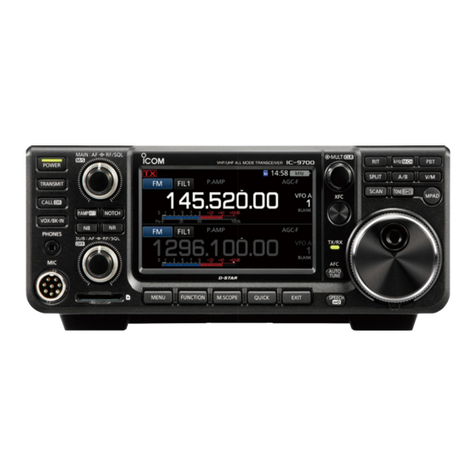
Icom
Icom IC-9700 Setup guide
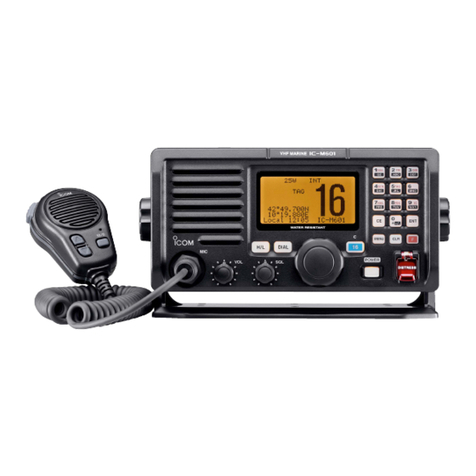
Icom
Icom IC-M601 User manual
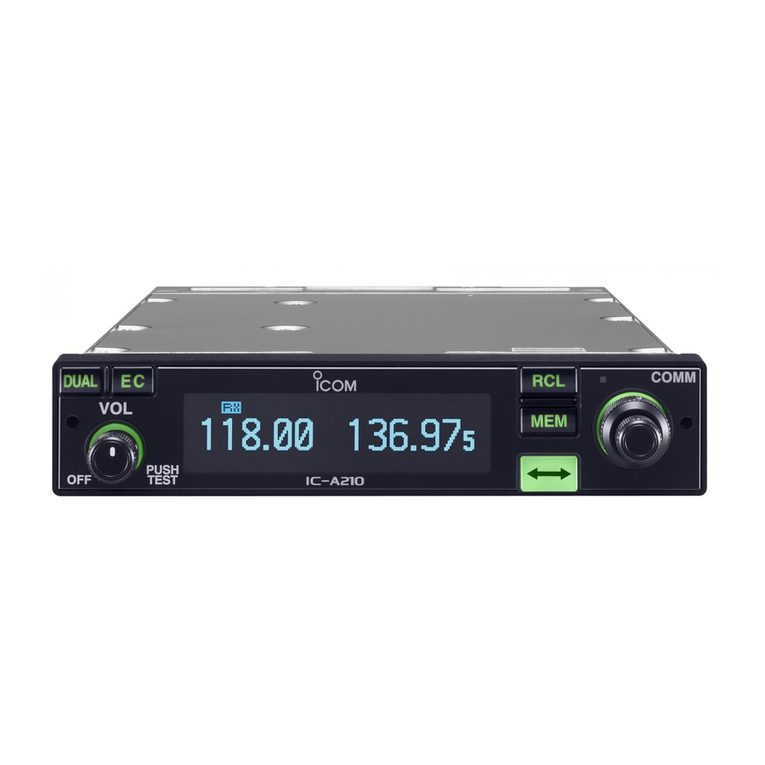
Icom
Icom IC-A210 User manual
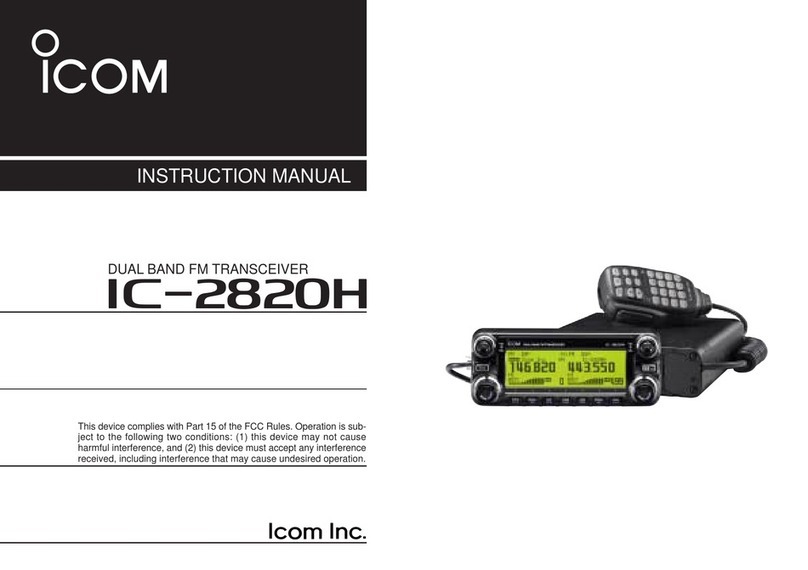
Icom
Icom IC-2820H User manual
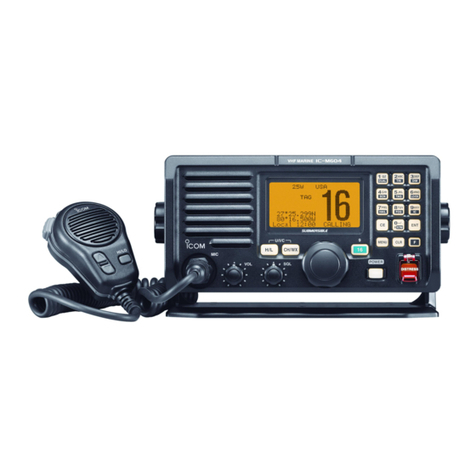
Icom
Icom IC-M604 User manual
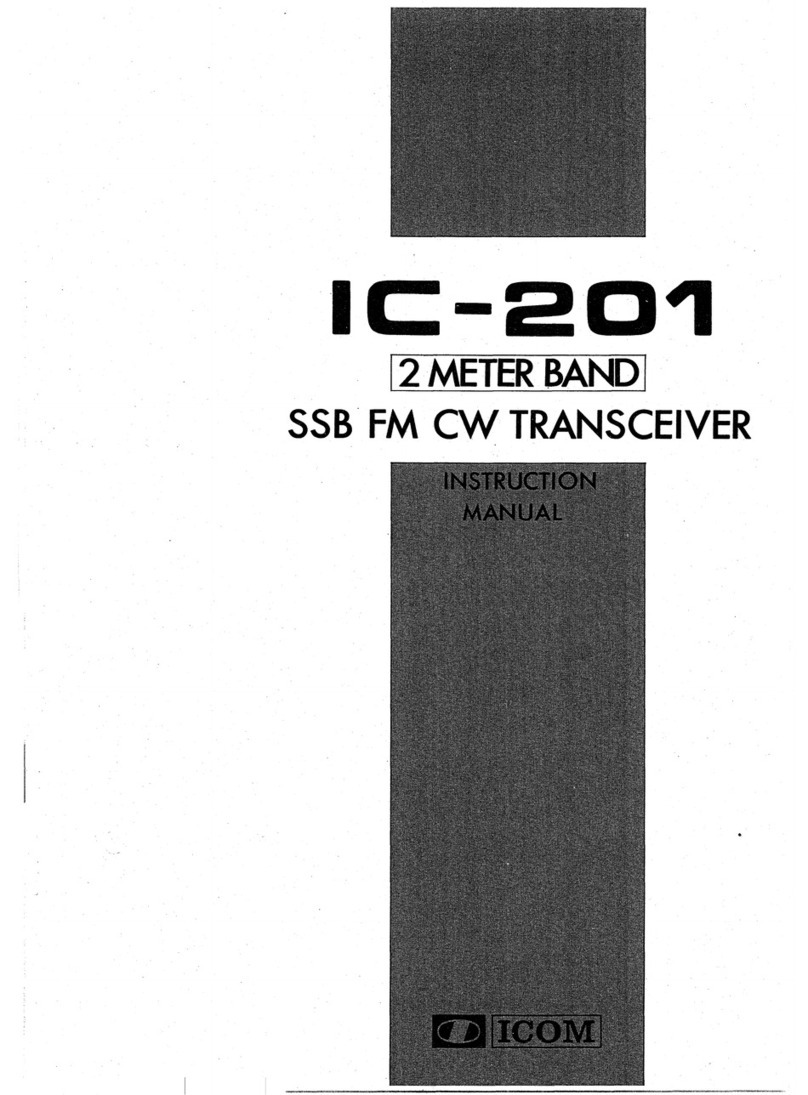
Icom
Icom IC-201 User manual
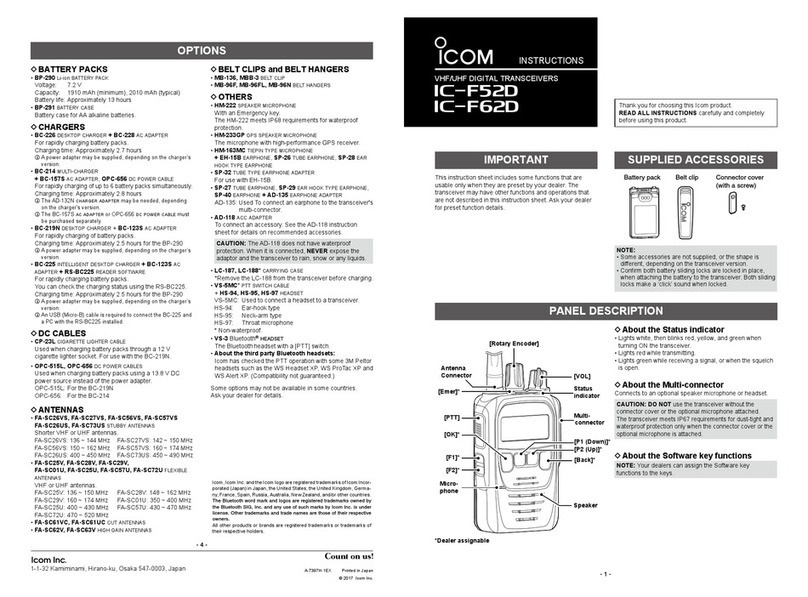
Icom
Icom IC-F52D User manual

Icom
Icom IC-F3021T User manual
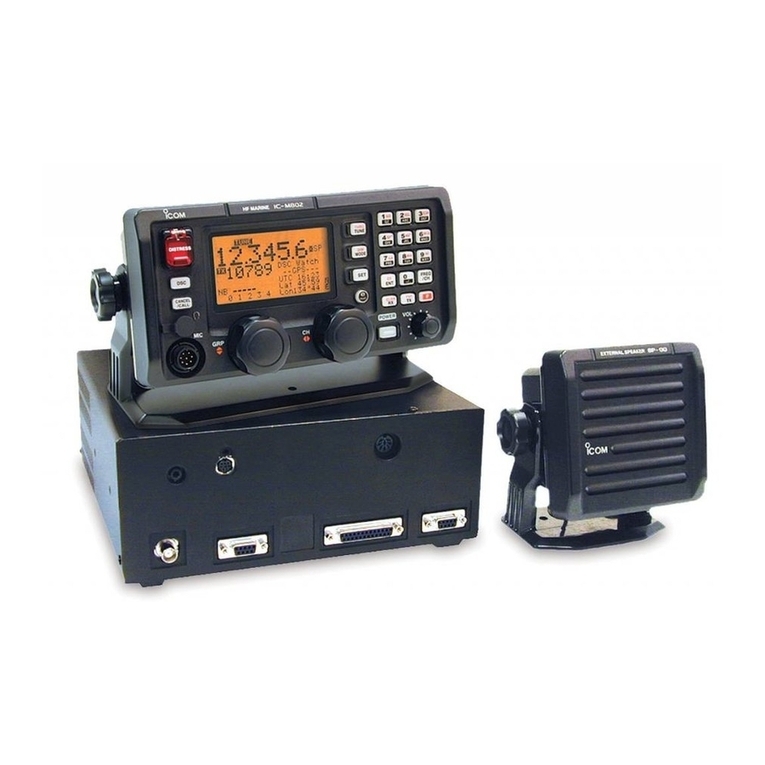
Icom
Icom IC-M802 User manual

Icom
Icom IC-9700 Installation and operating instructions
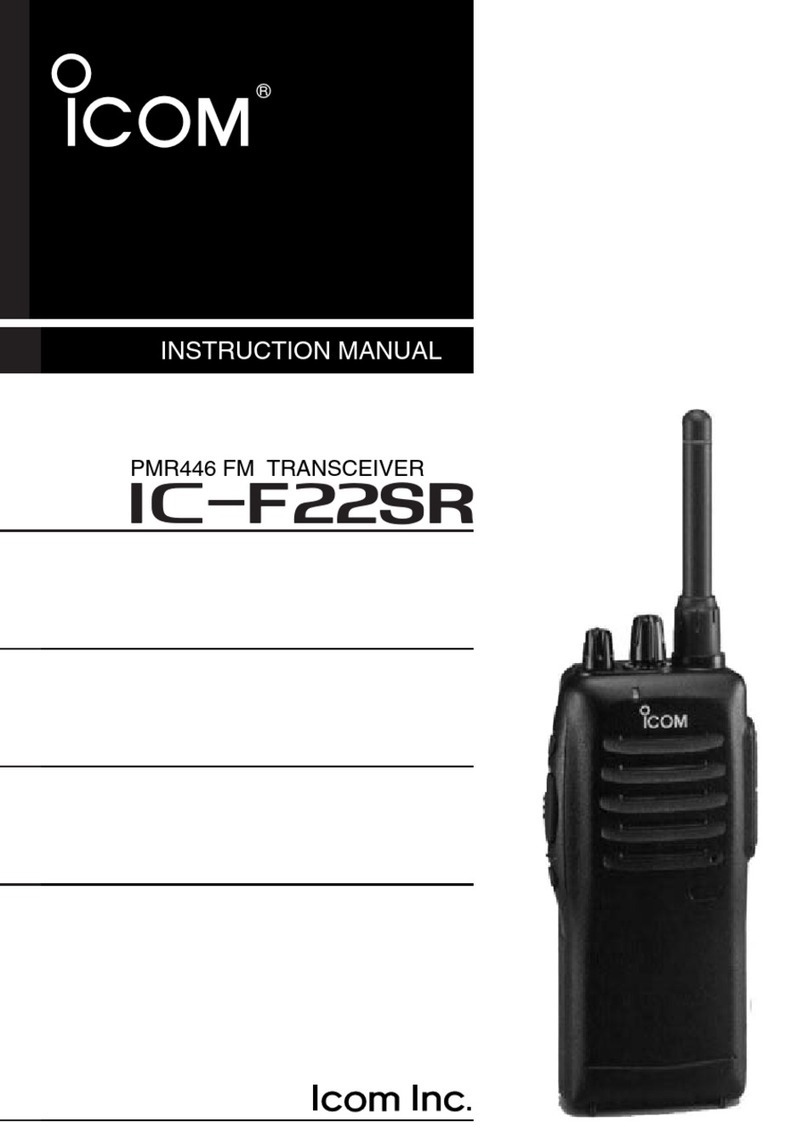
Icom
Icom iF22SR User manual

